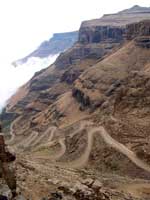 |
The
Karoo large igneous province: Lithosphere versus
mantle plume contribution |
F. Jourdana,b,c*,
H. Bertrandb, U.
Schärera,
J. Blichert-Toftb, G.
Férauda,
A.B. Kampunzud,§
aUMR-CNRS 6526 Géosciences Azur, Université de
Nice-Sophia Antipolis, O6108 Nice, France
bUMR-CNRS
5570, Ecole Normale Supérieure
de Lyon et Université Claude Bernard,
69364 Lyon, France
cBerkeley
Geochronology Center; 2455 Ridge Rd., Berkeley, CA94709,
USA
dDepartment
of Geology, University of Botswana, Gaborone, Botswana
*Present address: Western Australian Argon
isotope facility, Curtin university of Technology & JdL
Centre, GPO Box U1987, Perth, WA 6845, Australia, f.jourdan@curtin.edu.au
§Deceased,
2004
Introduction
The lower Jurassic is marked by the emplacement of
one of the largest continental flood basalts (CFB)
on Earth (≥ 3 x 106 km3).
The ~180 Ma Karoo magmatic province is located in southern
Africa, with minor patches in Antartica, and consists
of tholeiitic lava flows, sills, and giant radiating
dyke swarms emplaced prior to the breakup of southern
Gondwana and the opening of the SW Indian Ocean and
the Southern Ocean (e.g., Cox, 1988). It was
emplaced between 174 and 185 Ma (Figure 1; Le
Gall et al.,
2002,
Jourdan et al., 2004; 2005; 2007a; 2007b;
2007c; Jourdan et al., submited). It consists, at the
present time, of widespread remnants of basalts (lava
flows and sills) and giant dyke swarms (Figure 1).
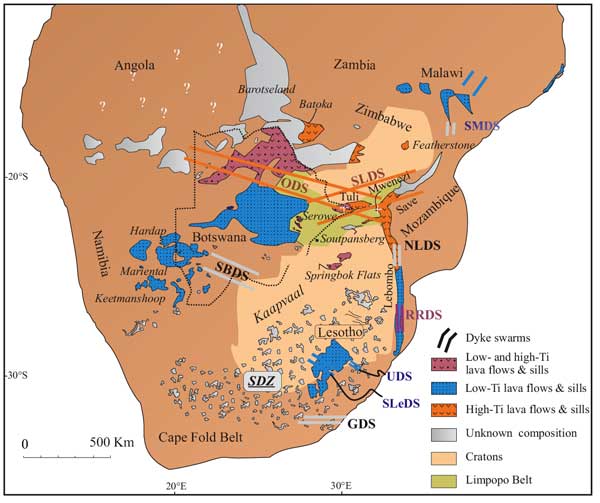
Figure 1: Sketch map of southern Africa
showing the distribution of the Karoo magmatism and
related dyke swarms (modified from Jourdan
et al., 2004 and references
therein). ODS: Okavango dyke swarm; SLDS: Save-Limpopo
dyke swarm; SBDS: South Botswana dyke swarm; SleDS:
South Lesotho dyke swarm; UDS: Underberg dyke swarm;
SMDS: South Malawi dyke swarm; RRDS: Rooi Rand dyke
swarm; NLDS: north Lebombo dyke swarm; GDS: Gap dyke
swarm; SDZ: sill-dense zone.
All geochemical investigations concur
that enriched sub-continental lithospheric mantle (SCLM)
contributed substantially to the Karoo CFB. Whereas
some authors maintain that only the SCLM melted (e.g.,
Duncan et al., 1984; Ellam & Cox, 1989), others
envisage that the SCLM may have mixed with asthenospherically
(plume?) derived magmas (Ellam & Cox, 1991; Sweeney
et al., 1994) with an ocean island basalt (OIB) -like
signature (Ellam et al., 1992). Here we attempt to
bridge this gap by presenting major and trace element
abundances reported for 147 samples and Sr, Nd, Hf,
and Pb isotope compositions reported for a 36 sample
subset of basaltic lava flows, sills, and dykes from
the Karoo CFB in Botswana, Zimbabwe, and northern South
Africa (see Jourdan et al., 2007a for more details).
Overview of the geochemistry of the Karoo magmatic
province
Geochemical studies conducted so far
have focused mainly on the lava flows and a few dykes
from the eastern and southern parts of the Karoo province
and provide constraints on the origin and genesis of
these magmas. The rocks can be subdivided into five
groups:
- The Mashikiri nephelinites (MgO = 2.6 to 12 wt.%)
are located in the Mwenezi district and display
significant incompatible trace-element enrichment
and extremely low εNdi (-9.8 to
-20.9) for fairly radiogenic Sr (Harmer et
al., 1998). They have
been interpreted as reflecting ancient metasomatically
enriched SCLM (Hawkesworth et al., 1984; Harmer
et al., 1998).
- The picrites (MgO = 10-24 wt.%)
of the Letaba Formation are mostly restricted to
the Mwenezi area, but are of greater volume and extent
than the nephelinites. An origin from ancient enriched
SCLM akin, but not identical, to the source of the
nephelinites was first proposed (e.g.,
Hawkesworth et al., 1984). Later, the pricrites were re-interpreted
as mixing between either ambient asthenospheric mantle
and SCLM (Ellam & Cox,
1991) or, based on Os isotopes, SCLM and mantle plume
magmas (Ellam & Cox, 1992). Most recently, based
on new Pb and Hf isotope data, Ellam (2006) proposed
a derivation from either a heterogeneous lithospheric
mantle source or a more complex mixture of source components.
- The
tholeiitic basalts and dolerites, which constitute
the overwhelming majority of Karoo rocks, have
been classified into two sub-groups, the low- and
high-Ti groups, on the basis of their TiO2,
P2O5,
and incompatible trace-element contents, with the
limit set at 2.0-2.5 wt.% TiO2. These
two groups show strong geographic provinciality
(Figure 1). The origins of the high- and low-Ti
sub-provinces have yet to be agreed upon, as they
have so far been ascribed to either heterogeneous
SCLM (e.g.,
Duncan et al., 1984) or mixing between asthenospheric
mantle and SCLM (e.g., Sweeney
et al., 1994).
- The rhyolites capping the basaltic lava
pile in Lebombo and Mwenezi encompass a wide range
of isotopic values from mantle-like to extreme crustal
signatures (Harris & Erlank, 1992).
- The MORB-like
Rooi Rand dyke swarm (Figure 1) emplaced along the
southern part of the Lebombo monocline is interpreted
as the final stage of Karoo magmatism, occurring
just prior to the onset of ocean floor spreading
(Duncan et al., 1990).
The mantle sources
of the Karoo CFB
Our approach
A key point at issue concerning the
origin of the Karoo CFB is whether the mantle sources
involved reside within the subcontinental lithospheric
mantle (e.g.,
Hawkesworth et al., 1984), are part of a mantle
plume head (Campbell & Griffiths, 1990),
or both (e.g., Sweeney et al., 1994). In the
following discussion, we present scenarios
involving:
- heterogeneous SCLM, and
- progressive mixing
between a mantle plume and the SCLM.
Regardless of
the scenario considered, a strong SCLM contribution
is required.
Evidence for a major SCLM component
-
Light ion lithophile element (LILE)
enrichment and the presence of high field-strength
elements (HFSE - Nb in particular) negative anomalies
for both the low- and high-Ti basalts and picrites;
-
the Nb anomaly is particularly
pronounced in the picrites ( Jourdan et al., 2007a),
which cannot be suspected of having undergone substantial
crustal contamination ( Ellam
& Cox, 1989; 1991);
- a SCLM component is supported by the composition
of clinopyroxenes from lherzolite xenoliths sampled
by kimberlites beneath the Kaapvaal craton, which
display LREE enrichment and HFSE depletion (selective
LILE/HFSE fractionation, strong Nb depletion, and
the absence of Zr-Hf anomalies; Grégoire
et al., 2003);
-
a "wet" mantle source
as shown by the occurrence of (i) biotite in early
peridotite cumulates from the Mount Ayliff layered
intrusion (related to the Karoo sill system - H.
Bertrand, unpublished data), and (ii) amphibole
and/or phlogopite in South African mantle xenoliths
(Grégoire et al., 2003);
-
the picrites and high-Ti lava
flows have in common that they are the least radiogenic
in Nd and Hf, the most radiogenic in 207Pb
and 208Pb,
and approach the isotopic signature of some extreme
alkaline magmas (Figures 2c, e, f) such as lamproites
and more particularly the Karoo nephelinites. This
suggests that they must have first have been strongly
enriched by subduction and metasomatic processes
(e.g.,
Mitchell & Bergman,
1991) and subsequently isolated for a long time
from mantle convection (Murphy et
al., 2002).
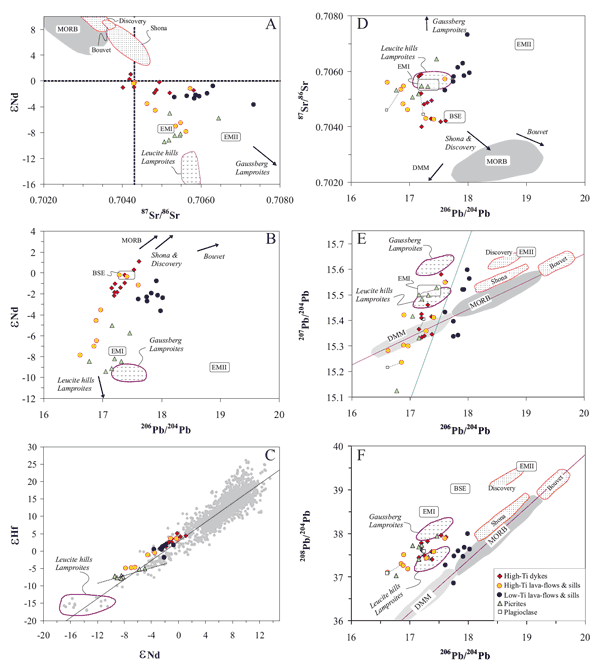
Figure
2. Initial (179 Ma) Sr, Nd, Hf, and Pb isotopic compositions
of the Botswana Karoo rocks and plagioclase separates
from rocks Bot0098 and P11-2 (open squares linked
to their respective whole rocks by tie-line). Click
here or
on figure for enlargement.
Scenario I: The Karoo mantle sources are a heterogeneous
lithospheric mantle
Our data can be interpreted in terms of heterogeneous
metasomatised SCLM and do not require a chemical contribution
from a mantle plume.
When the Botswana - Zimbabwe Nd-Sr
isotopic data are plotted alongside those previously
published (Georoc database) (Figures 2a & 3), most
of the high-Ti lava flows and picrites form a well-defined
trend from bulk silicate Earth (BSE), as also represented
by some southern Africa SCLM xenoliths (e.g.,
Erlank et al., 1987), towards compositions with
highly negative εNdi – down to -22), similar to lamproites
and nephelinites.
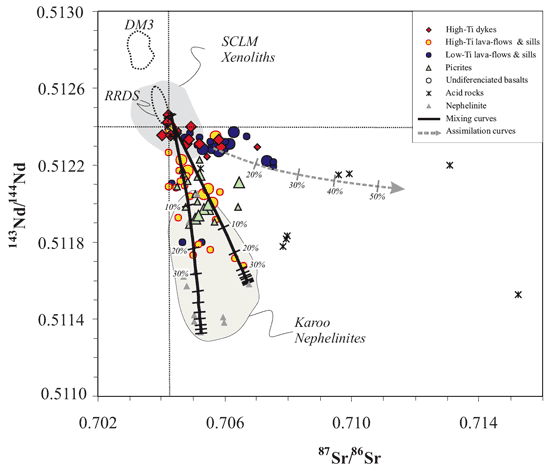
Figure 3. Initial 143Nd/144Nd vs. 87Sr/86Sr. Mixing curve (solid
black line) end-members: nephelinite and ijolite both
mixed with SCLM xenoliths. Dashed grey curve represents
EC-AFC-calculated upper crustal assimilation of low-Ti
rocks. Large symbols = present study, small symbols
= Karoo Georoc data.
Compared to this main array, the high-Ti dykes and
the low-Ti lava flows form another distinct trend departing
from the same BSE-like end-member, but diverging towards
enriched Sr isotope ratios. Beyond the effects of secondary
processes, the samples with the least radiogenic Sr
probably have source characteristics (in terms of Sr-Nd
isotopes) close to those of other BSE-like high-Ti
rocks. Therefore, most of the Nd-Sr isotopic range
of the primary magmas (the solid trends on Figure 3)
can be modeled by mixing between a BSE-like and a nephelinite-like
component. They therefore could reflect the degree
of heterogeneity of the SCLM.
However, in εNdi-206Pb/204Pbi space (Figure 2b), some source differences between
the low- and high-Ti groups stand out. To get a better
understanding of their origin, the εHf and Ba/La vs.
Th/Yb diagrams (Figure 4) are useful, as these variables
are reliable indicators of potential sediment or fluid
contributions to arc-like sources (Woodhead
et al.,
2001). Figure 4 suggests that sediments contribute
to the mantle source of the high-Ti magmas, whereas
low-Ti magmas more likely originated from a source
enriched by fluids.
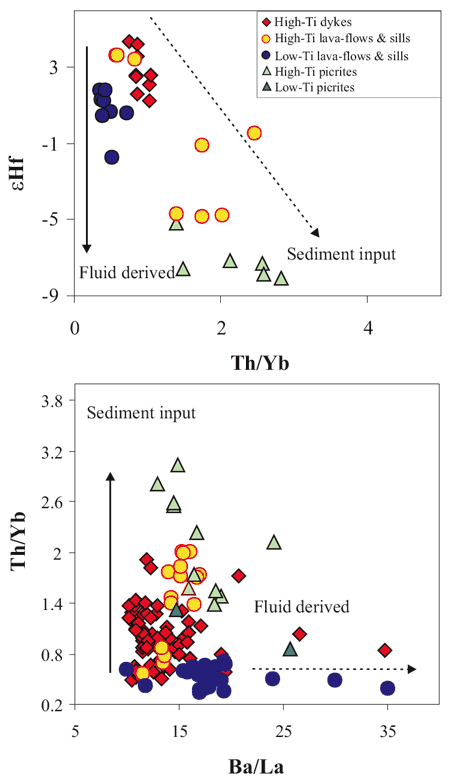
Figure 4. Hf and Ba/La
vs. Th/Yb. Solid vector: slab-derived fluids; dashed
vector: sediment input in the source as represented
and discussed by Woodhead et al. (2001).
Lithosphere architecture and the distribution of low-
and high-Ti magmas
Griffin et al. (2003) recently provided
a compositional and structural map in four dimensions
of the lithospheric mantle underlying the Kaapvaal
craton and the surrounding mobile belts (Figure 1),
highlighting the strong vertical and lateral heterogeneity
of the SCLM. One of the most striking features is strong
geochemical depletion in the depth interval 120 - 180
km below the Limpopo belt.
The high-Ti rocks are restricted mostly
to the Limpopo-Shashe mobile belt (Figure 1). This
suggests that Limpopo-Shashe mobile belt structure
may have been a controlling factor in the distribution
of the high-Ti magmas.
According to our calculations (Jourdan
et al.,
2007a),
the high-Ti magmas require garnet in their source
(Figure 5), implying a deep (> 80 km) melting
zone below the Limpopo-Shashe belt, as opposed to the
shallow melting zone of the spinel-bearing mantle source
generating the low-Ti magmas elsewhere (Figure 1 & 5).
The depleted harzburgitic zone identified at 120
- 180 km depth below the Limpopo belt is unsuitable
for producing significant amounts of melting. However,
at depths greater than 200 km, the presence of strongly
metasomatised peridotites has been documented (Griffin
et al., 2003) and represents a relatively fertile
zone for magma supply at the garnet-bearing base of
the SCLM, which is 200 - 300 km thick (James
et al.,
2001).
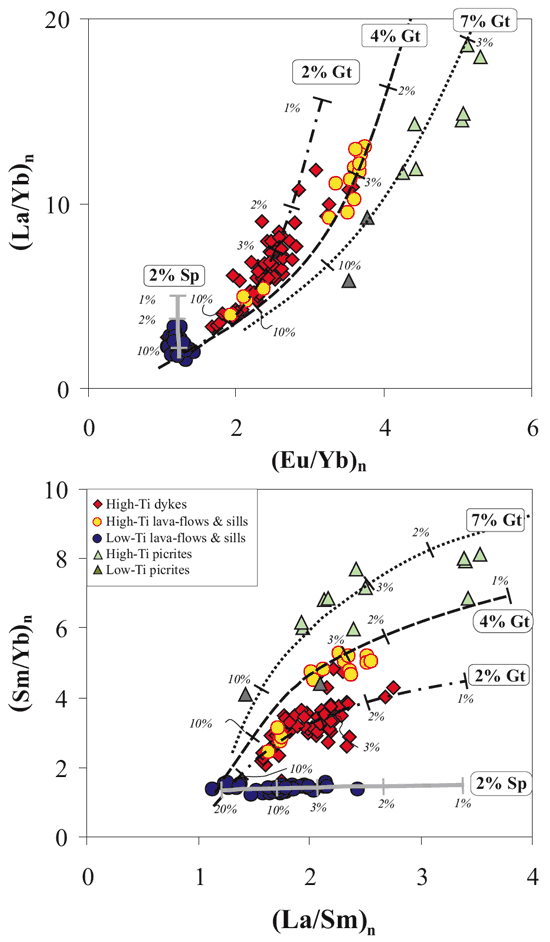
Figure 5. (La/Yb)n vs. (Eu/Yb)n and (Sm/Yb)n vs. (La/Sm)n for the Botswana Karoo
rocks and non-modal batch melting modeling of a lherzolitic
mantle source. See details in Jourdan et al. (2007a).
As an example, in the 143Nd/144Ndi vs. 87Sr/87Sri plot (Figure 3),
the trend between the high-Ti picrites, enriched in
Nd-Hf isotope space, and the BSE-like mantle source
may be interpreted as follows:
- the highly enriched
picritic (and some basaltic high-Ti) magmas could reflect
the contribution of deep vein-like material percolating
through the base of the SCLM, possibly recflecting
sediment input (Figure 4);
- the BSE-like mantle
is more likely to represent the SCLM itself, playing
the role of matrix to the veins and enriched by fluid-related
processes (Figure 4);
In this scenario, we emphasize the importance of the
strong vertical and horizontal heterogeneity of the
SCLM, consistent with the general picture inferred
from mantle xenoliths (Griffin
et al., 2003).
Scenario II: Mixing between lithospheric
and sub-lithospheric (plume) mantle
Although this scenario is geologically
feasible, we feel that its additional complexity
(compared to Scenario I) makes it less likely.
However, as it cannot be disproved, and in order to
stay objective, we discuss it and leave the reader
to draw his/her own conclusions about it.
As explained
above, Karoo nephelinites and picrites are likely to
represent an SCLM-enriched end-member. We now envisage
an additional sub-lithospheric component with a slightly
depleted isotopic composition. Because of the chemical
contrast between this component and the extremely incompatible-trace-element-enriched
veined SCLM, mixing between these two end-members would
be strongly affected (and masked) by the SCLM signature
(e.g., Ellam, 2006).
The rocks with the compositions closest to this sub-lithospheric
component are the high-Ti Okavango dykes and the low-Ti
basalts. A gradually increasing contribution from a
mantle plume component as the Sr and Nd isotopic compositions
of the Karoo rocks approach BSE (Figure 3) also is
in accordance with the observed decrease of the size
of the negative Nb anomaly (from the picrites to the
high-Ti dykes). The low-Ti basalts may represent the
most "plume-like" end-member of the southern
Africa Karoo suite (e.g., Figure 2f).
Mixing between the SCLM and a mantle plume component.
In this scenario, Karoo magmatism is hypothesized to
have started by the arrival of a mantle plume at the
base of the SCLM near the Mwenezi area. The plume provided
sufficient heat to melt the alkaline veins (see discussion
in Scenario 1) at the base of the lithospheric mantle
beneath the Limpopo belt (in the garnet-bearing lherzolite
facies) and gave rise to the Karoo nephelinites by
low degrees of melting. The subsequent progressive
ascent of the mantle plume allowed the melting of both
itself and the SCLM. This process generated first the
high-Ti (low degrees of melting) and then the low-Ti
(slightly higher degrees of melting; Figure 5) picrites.
Because of the progressive thermal and mechanical erosion
of the SCLM and/or lithospheric extension due to the
ongoing rifting, the plume continued to rise and expand
and contributed increasingly to magma production. The
resulting mixtures are reflected in the magmatic evolution
from high-Ti/high-incompatible-trace-element basalts
over high-Ti basaltic dykes to high-Ti/low-incompatible-trace-element
basalts as the plume ascended. An increasing contribution
from the mantle plume with decreasing influence of
the SCLM is suggested by the progressive reduction
of the negative Nb anomaly.
In this Scenario, we propose two end-members represented
by
- the metasomatically enriched alkalic veins of
the SCLM, and
- a sub-lithospheric (asthenospheric-
or OIB-like?) mantle plume.
Our data
are consistent with a progressive increase of a mantle
plume contribution as the plume rises and expands
through a laterally and vertically heterogeneous
lithosphere.
Conclusions
The isotopic variations and LREE/HFSE
fractionation of both low- and high-Ti magmas suggest
that a sub-continental lithospheric mantle (SCLM) component
predominates in the Karoo magmatism. The Karoo magmatic
sequence can be explained equally well by two contrasting
scenarios between which the present data cannot distinguish
unambiguously. In the first, the magmas are derived
from a heterogeneous SCLM, metasomatically enriched
in the form of veins (sediment input?) during ancient
subduction events. The Karoo magmas document the polybaric
melting from a deeper "nephelinite-veined" (the
most incompatible-trace-element-enriched basaltic lava
flows and picrites) to a shallower BSE-like (high-Ti
dykes, low-Ti and the least incompatible-trace-element-enriched
high-Ti lava flows) SCLM. In the second scenario, the
different magma types reflect mixing between the veined
SCLM proposed in the first scenario and a (OIB- or
asthenospheric-like?) mantle plume. The contribution
of the mantle plume to the Karoo magmas is minimal
for the nephelinites and increases progressively as
the plume rises and expands through a laterally and
vertically heterogeneous lithosphere (i.e. increases
from high-Ti picrites to low-Ti basalts).
The distribution of the high- and low-Ti magmas reflects
strong control by lithospheric architecture. The high-Ti
magmas are restricted to above the thick Limpopo belt
lithosphere, whereas the low-Ti magmas are located
on the thinner (and vein-free) Kaapvaal and Zimbabwe
cratonic lithospheres. The occurrence of a low-εNdi,
low-εHfi, and low-206Pb/204Pbi mantle source (thick
veined SCLM?) is possibly due to higher degrees of
subduction-related metasomatism (and sediment input?)
beneath the Limpopo belt.
References
-
Cox, K.G. (1988). The Karoo Province. In: J.D. MacDougall
(Ed), Continental Flood Basalts. Kluwer, 239-271.
-
Duncan,
A.R., Erlank, A.J. & Marsh, J.S. (1984).
Regional geochemistry of the Karoo igneous province.
In: A.J. Erlank (Eds), Petrogenesis
of the volcanic rocks of the Karoo province. Special Publication
of the Geological Society of South Africa 13, 355-388.
-
Duncan
A. R., Armstong R.A., Erlank, A.J., Marsh, J.S & Watkins,
R.T. (1990). MORB-related dolerites associated
with the final phases of Karoo flood basalt volcanism
in southern Africa. In A. J. Parker, Rickwood,
P.C., Tucker, D.H. (Eds) Mafic
dykes and emplacement mechanisms. Rotterdam: Balkema, 119-129.
-
Ellam, R.M. & Cox,
K.G. (1989). A Proterozoic lithospheric source
for Karoo magmatism: evidence from the Nuanetsi
picrites. Earth and Planetary
Science Letters 92,
207-218.
-
Ellam,
R.M. & Cox, K.G. (1991). An interpretation
of Karoo picrite basalts in terms of interaction
between asthenospheric magmas and the mantle lithosphere.
Earth and Planetary Science
Letters 105, 330-342.
-
Ellam,
R.M., Carlson, R.W. & Shirley, S.B. (1992).
Evidence from Re-Os isotopes for plume-lithosphere
mixing in Karoo flood basalt genesis. Nature 359,
718-721.
-
Ellam, R.M. (2006). New
constraints on the petrogenesis of the Nuanetsi
picrite basalts from Pb and Hf isotope data. Earth
and Planetary Science Letters 245, 153-161.
-
Erlank, A.J., Hawkesworth,
C.J., Harggerty, S.E., Allsopp, H.L., Rickard,
R.S. & Menzies,
M.A., (1987). Evidence for mantle metasomatism
in peridotite nodules of the Kimberley pipes, South
Africa. In: Hawkesworth,
C.J. & Menzies, M. (Eds), Mantle
metasomatism.
New York: Academic Press, 221-331.
-
Grégoire, M., Bell, D.R. & Le
Roex, A.P. (2003). Garnet lherzolites from the
Kaapvaal Craton (South Africa): Trace element evidence
for a metasomatic history. Journal
of Petrology 44, 629-657.
-
Griffin,
W.L., O'Reilly, S. Y., Natapov, L.M. & Ryan,
C.G. (2003). The evolution of lithospheric mantle
beneath the Kalahari Craton and its margins. Lithos 71, 215-241.
-
Harris C. & Erlank A.J.
(1992). The production of large-volume, low-_18O
rhyolites during the rifting of Africa and Antarctica:
the Lebombo monocline, southern Africa. Geochimica
et Cosmochimica Acta 56, 3561-3570.
-
Harmer, R.E., Lee, C. A. & Eglington,
B. M. (1998). A deep mantle source for carbonatite
magmatism: evidence from the nephelinites and carbonatites
of the Buhera district, SE Zimbabwe. Earth
and Planetary Science Letters 158, 131-142.
-
Hawkesworth, C.J., Marsh,
J.S., Duncan, A.R., Erlank, A.J. & Norry, M.J.
(1984). The role of continental lithosphere in
the generation of the Karoo volcanic rocks: evidence
from combined Nd- and Sr-isotope studies. In: Erlank,
A.J. (Eds), Petrogenesis of
the volcanic rocks of the Karoo province. Special
Publication of the Geological Society of South
Africa 13, 341-354.
-
James, D.E., Fouch, M.J.,
VanDecar, J.C., Van Der Lee, S. & Kaapvaal
Seismic Group (2001). Tectospheric structure beneath
southern Africa. Geophysical
Research Letters 28,
2485-2488.
-
Jourdan,
F., Féraud, G., Bertrand, H., Kampunzu,
A.B., Tshoso, G., Le Gall, B., Tiercelin, J.J. & Capiez
P. (2004). The Karoo triple junction questioned:
evidence from 40Ar/39Ar Jurassic
and Proterozoic ages and geochemistry of the Okavango
dyke swarm (Botswana). Earth and Planetary
Science Letters 222,
989-1006.
-
Jourdan,
F., Féraud,
G., Bertrand, H., Kampunzu, A.B., Tshoso, G., Watkeys,
M.K. & Le
Gall., B. (2005). The Karoo large igneous province:
Brevity, origin, and relation with mass extinction
questioned by new 40Ar/39Ar
age data, Geology 33,
745-748.
-
Jourdan,
F., Bertrand, H., Sharer, U., Blichert-Toft,
Féraud, G., Kampunzu,
A.B., Le Gall, B., Watkeys, M.K., Major-trace element
and Sr-Nd-Hf-Pb isotope compositions of the Karoo
large igneous province in Botswana-Zimbabwe (2007a). Journal of Petrology 48, 1043-1077.
-
-
Jourdan,
F., Féraud,
G., Bertrand, H., Watkeys, M.K., Renne, P.R., 2007c.
Distinct brief major events in the Karoo large
igneous province clarified by new 40Ar/39Ar
ages on the Lesotho basalts. Lithos 98, 195-209.
-
Jourdan, F., Féraud,
G., Bertrand, H. & Watkeys,
M.K., Renne, P.R. 40Ar/39Ar ages
of the sill complex of the Karoo large igneous
province: relationship between geodynamics and
climate change. (submitted).
-
Le
Gall, B., Tshoso, G., Jourdan, F., Féraud,
G., Bertrand, H., Tiercelin, J.J., Kampunzu, A.B. Modisi,
M.P., Dyment, M. & Maia J. (2002). 40Ar/39Ar
geochronology and structural data from the giant
Okavango and related mafic dyke swarms, Karoo igneous
province, Botswana. Earth
and Planetary Science Letters 202, 595-606.
-
Mitchell, R.H., & Bergman,
S.C. (1991). Petrology of
Lamproites. New York:
Plenum.
-
Murphy, D.T.,
Collerson, K.D. & Kamber, B.S.
(2002). Lamproites from Gaussberg, Antarctica:
possible transition zone melts of Archaean subducted
sediments. Journal of Petrology 43, 981-1001.
-
Sweeney, R.J., Duncan,
A.R. & Erlank, A.J. (1994).
Geochemistry and petrogenesis of Central Lebombo
basalts from the Karoo Igneous Province. Journal
of Petrology 35, 95-125.
-
Woodhead, J.D., Hergt, J.M.,
Davidson, J.P. & Eggins,
S.M. (2001). Hafnium isotope evidence for 'conservative'
element mobility during subduction zone processes.
Earth and Planetary Science
Letters 192, 331-346.
last updated 7th
December, 2007 |
